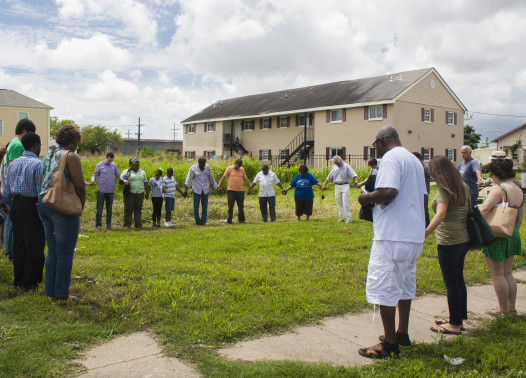
Community members join hands for a short service near the Zion City Greater St. James Church after guest speeches. (Photo: Hanna Rasanen)
Though many people may not realize it, blighted properties in New Orleans were a major problem even before Hurricane Katrina. In the years since, communities have continued the fight against these urban eyesores.
On the morning of June 28, Zion City, also known as Gert Town, opened a community park, and also unveiled new tools in the fight against eradicating blighted properties. Council member LaToya Cantrell spoke at the event, confiding that she is a victim of having to live near blighted properties. Residents fear that having an assortment of blighted properties in the area diminishes the value of the community, as well as being host to serious safety concerns.
Currently, there are more than 30,000 blighted properties in the greater New Orleans area. Cantrell, as well as community members at the event on Saturday, agreed that community organization is the preferred method of fighting blight.
Two essential tools for combating blight were announced at the meeting: the Blight Resource Guide and the Organizing Toolkit. The resource guide is a comprehensive list of resources available to combat blighted properties in New Orleans communities; it tells citizens how to recognize what constitutes a blighted property and what are their rights when it comes to facing them. In-person trainings, to go along with the material that is part of the Blight Organizing Toolkit, will begin in fall 2014. The toolkit includes training for neighborhood leaders on how to deal with a range of issues that arise from blighted properties.
At the meeting, volunteers helped build and paint a set of benches for the community park, the land for which was blessed after the presentation of the two tools. Community members and volunteers held hands in a circle to pray for the community itself and the park. The park, which became a reality thanks to consistent urging by community members, will be erected on two plots of cleaned-up land and will include the benches that community members and volunteers worked together to create during the meeting.
An online version of the resource guide can be found online at NolaBlightGuide.com and at GNOHA.org
 NOLAbeings Multimedia artist Claire Bangser created NOLAbeings as a portrait-based story project that marries...
NOLAbeings Multimedia artist Claire Bangser created NOLAbeings as a portrait-based story project that marries...  Voodoo in New Orleans: Reviving history: New Orleans fortune telling This article takes a deep dive into the history of Voodoo in New Orleans, its hybridization with Catholicism, and its present-day place in the city's culture. The author visits fortune-tellers in the French Quarter, using their guidance as a tool for introspection rather than a deterministic predictor of the future. Through her experiences in New Orleans, the author feels a mystical connection to both the past and the future.
Voodoo in New Orleans: Reviving history: New Orleans fortune telling This article takes a deep dive into the history of Voodoo in New Orleans, its hybridization with Catholicism, and its present-day place in the city's culture. The author visits fortune-tellers in the French Quarter, using their guidance as a tool for introspection rather than a deterministic predictor of the future. Through her experiences in New Orleans, the author feels a mystical connection to both the past and the future. 